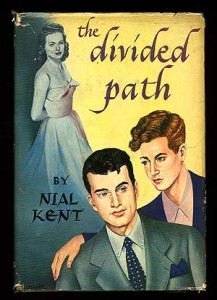SIX YEARS AGO, I began working on an anthology entitled Pulp Friction, which started out as a lighthearted look at the pulp novels of the 1950’s and 1960’s. While Pulp Friction was never intended to be a throwaway book, I originally envisioned it as a nostalgic walk through what I imagined to be a world of outdated and—to our eyes now—probably simpleminded, even homophobic fiction. Sure, the old covers, with their garish colors, lurid images, and often suggestive tag lines—“A Surging Novel of Forbidden Love,” “The Story of Men Who Don’t Belong”—were fun when reproduced as refrigerator magnets, but it was hard for me to imagine the books as literature. And it was almost impossible to think that they were not relics from some far-distant, queer-hating era nearly obliterated by the truths of Gay Liberation. I could not have been more wrong.
I began considering what I would include in Pulp Friction by looking through my own fairly extensive collection of older gay novels and soft-core porn novels from the 1960’s and early 1970’s. My plan was somewhat unformulated. I knew there was a difference between a novel like Michael De Forrest’s The Gay Year, published by Woodford Press in 1949 (which I had in a 1967 Lancer paperback reprint), or Harrison Dowd’s 1950 The Night Air (Dial Press), on my shelf for years in its  first 1951 Avon paperback printing), and a 1967 soft-core porn novel like Gay Whore by Jack Love (probably not his real name), issued by the French Line of Publisher’s Export Company, one of the most prolific producers of porn in the mid-1960’s. Clearly The Gay Year and The Night Air aspired to be literary novels; Gay Whore aspired to, well, stimulate the reader in other ways. What connected these books in my thinking was that they were “pulps”—that is, they all had eye-catching covers and were published between the late 1940’s and some time before Stonewall.
first 1951 Avon paperback printing), and a 1967 soft-core porn novel like Gay Whore by Jack Love (probably not his real name), issued by the French Line of Publisher’s Export Company, one of the most prolific producers of porn in the mid-1960’s. Clearly The Gay Year and The Night Air aspired to be literary novels; Gay Whore aspired to, well, stimulate the reader in other ways. What connected these books in my thinking was that they were “pulps”—that is, they all had eye-catching covers and were published between the late 1940’s and some time before Stonewall.
I quickly discovered that what I had conflated as a broad genre of “pulp novels” was in reality a wide-ranging, extraordinarily rich, and extensive body of literature that existed before Stonewall and Gay Liberation. I also







